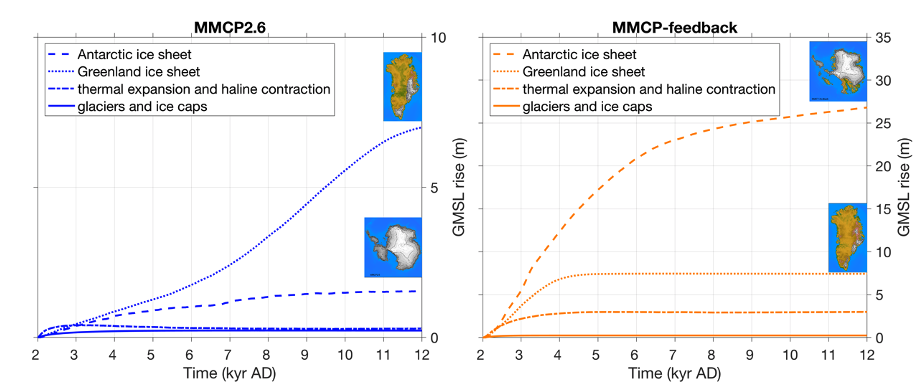Written by Heiko Goelzer, researcher at the Bjerknes Centre and NORCE
Most projections of global sea level rise run until the end of this century. However, the melting of entire ice sheets is a very slow process and once the ice sheets are out of balance, it may take hundreds to thousands of years before a new equilibrium is reached.
In our new study, published in the journal Earth System Dynamics, a group of researchers from Brussels and Bergen has made projections for sea level rise over the next 10,000 years, using coupled models of the Greenland and Antarctic ice sheets, the atmosphere and the ocean.
Jonas Van Breedam who led the study states: “Emissions of greenhouse gases over the next 30 to 200 years could result in a global average sea level rise of 9 to 37 metres over the next 100 centuries.”
We made projections for sea level rise over the next 10,000 years for a series of climate scenarios ranging from a CO2 peak over the next 30 years to the emission of most available CO2 reserves over the next 200 years. The highest scenario also takes into account an increased greenhouse effect when the permafrost on land and ocean floor melts and releases methane in large quantities.
Depending on these greenhouse gas emissions, sea levels could rise by between 9.2 m and 37.4 m in 10,000 years. The Greenland ice sheet disappears completely in all scenarios, while the Antarctic ice sheet remains largely intact in a low-emission scenario and could lose up to half of its mass in a high-emission scenario. It is only after 10,000 years that ice sheets come into balance with the surrounding climate and the change in sea-level falls back to a maximum of 5 cm per 100 years.
In the high-emission scenario, sea level rises by more than 1 m per century on average during the first 2,000 years. For the low-emission scenario, the rate of sea-level rise is 10 times lower for the same period, at an average of 11 cm per century. The rate of sea-level rise is thus highly dependent on the total amount of CO2 emitted.
Our study shows that the effect of current warming on ice sheets and sea level will remain visible for thousands of years, mainly due to the long response times of the Greenland and Antarctic ice sheets adjusting to a change in climate conditions.

Reference
Van Breedam, J., Goelzer, H., and Huybrechts, P.: Semi-equilibrated global sea-level change projections for the next 10 000 years, Earth Syst. Dynam., 11, 953–976, https://doi.org/10.5194/esd-11-953-2020, 2020.

